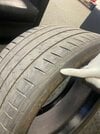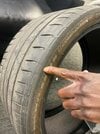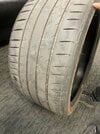That’s the problem with sentence fragments, the meaning can be unclear.
Is the wear on the involved tires equal on the inside and outside edges or is the wear asymmetrical? If it’s identical, then tire pressure is the main suspect. If asymmetrical, then one might look to the suspension/alignment. If it’s the inside edges, then camber might be the issue. Camber is the tire tilt when looking at it from the back. Many high performance cars tilt the rear tires so the tire runs more on the inside edge then when the car goes around an aggressive turn, the tire lays down flat and side slip is less. Further the tire formulations are stickier for traction, so not formulated for long wear. By dropping the suspension, you’ve altered the factory settings substituting settings of your own. If you know what you are doing, then you’ve probably improved handling. Still all that energy of the heavy car turning sharply at high speed grinds up the tires. If you lowered the car for looks alone, then you may have given up more in the way of factory optimized suspension settings than you gained by looking at full wheel wells. If you are running at 42 PSI instead of 45, the tires will be slightly softer further increasing wear.
The Tesla is very good at straight line acceleration. It isn’t really ideal for non straight high speed driving because the thing is so heavy. It doesn’t feel heavy when you drive it because you have all that instant effortless torque, but if you ever do an emergency abrupt turn at high speed, that thing will plow on forward like an old 1960’s Lincoln. For ideal racing turns, you want a light car with a stiff well turned suspension.
Good luck with all this. I’m probably wasting my breath suggesting you un-lower your car and return it to factory settings, but that’s the direction I’d go. Replacing tires every 7000 miles will get old.
Best,
David





